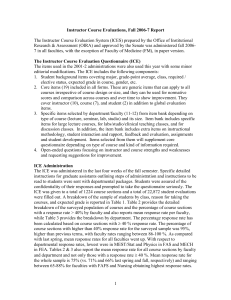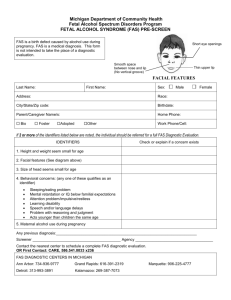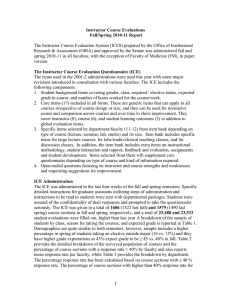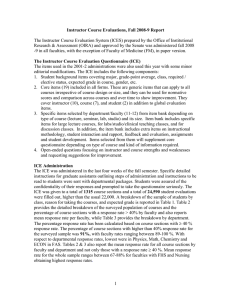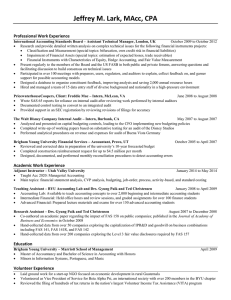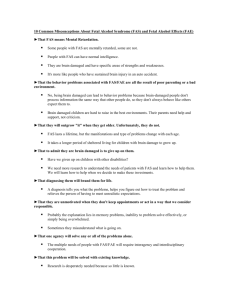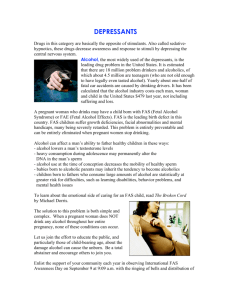ICE Summary Report Fall/Spring 2009-10
advertisement
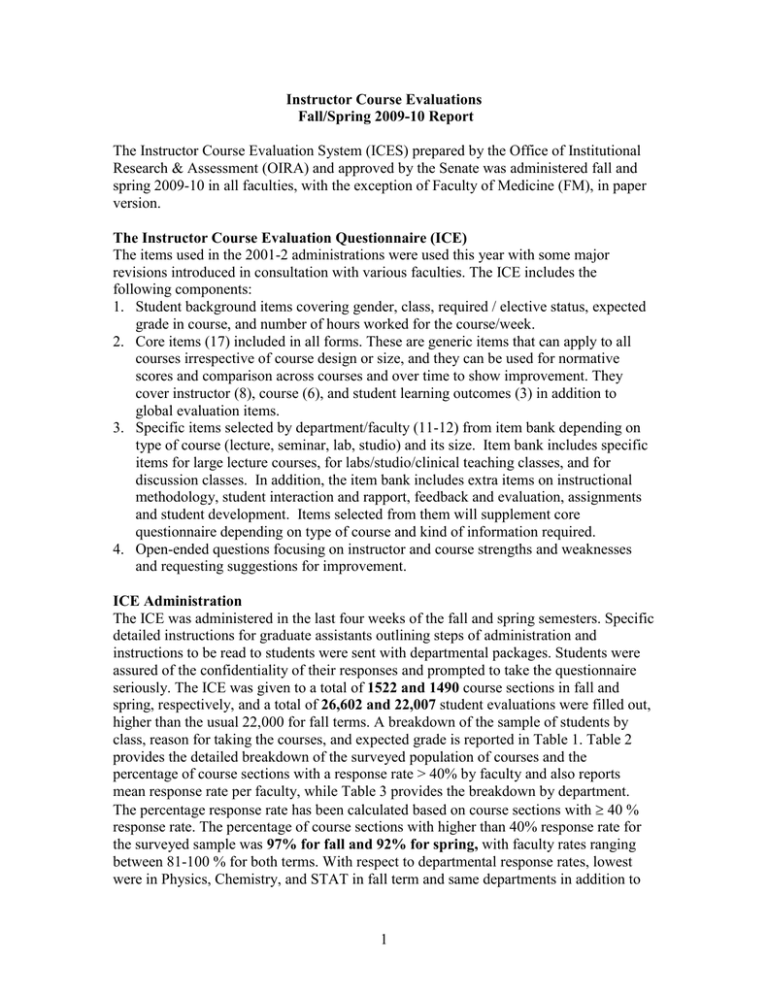
Instructor Course Evaluations Fall/Spring 2009-10 Report The Instructor Course Evaluation System (ICES) prepared by the Office of Institutional Research & Assessment (OIRA) and approved by the Senate was administered fall and spring 2009-10 in all faculties, with the exception of Faculty of Medicine (FM), in paper version. The Instructor Course Evaluation Questionnaire (ICE) The items used in the 2001-2 administrations were used this year with some major revisions introduced in consultation with various faculties. The ICE includes the following components: 1. Student background items covering gender, class, required / elective status, expected grade in course, and number of hours worked for the course/week. 2. Core items (17) included in all forms. These are generic items that can apply to all courses irrespective of course design or size, and they can be used for normative scores and comparison across courses and over time to show improvement. They cover instructor (8), course (6), and student learning outcomes (3) in addition to global evaluation items. 3. Specific items selected by department/faculty (11-12) from item bank depending on type of course (lecture, seminar, lab, studio) and its size. Item bank includes specific items for large lecture courses, for labs/studio/clinical teaching classes, and for discussion classes. In addition, the item bank includes extra items on instructional methodology, student interaction and rapport, feedback and evaluation, assignments and student development. Items selected from them will supplement core questionnaire depending on type of course and kind of information required. 4. Open-ended questions focusing on instructor and course strengths and weaknesses and requesting suggestions for improvement. ICE Administration The ICE was administered in the last four weeks of the fall and spring semesters. Specific detailed instructions for graduate assistants outlining steps of administration and instructions to be read to students were sent with departmental packages. Students were assured of the confidentiality of their responses and prompted to take the questionnaire seriously. The ICE was given to a total of 1522 and 1490 course sections in fall and spring, respectively, and a total of 26,602 and 22,007 student evaluations were filled out, higher than the usual 22,000 for fall terms. A breakdown of the sample of students by class, reason for taking the courses, and expected grade is reported in Table 1. Table 2 provides the detailed breakdown of the surveyed population of courses and the percentage of course sections with a response rate > 40% by faculty and also reports mean response rate per faculty, while Table 3 provides the breakdown by department. The percentage response rate has been calculated based on course sections with 40 % response rate. The percentage of course sections with higher than 40% response rate for the surveyed sample was 97% for fall and 92% for spring, with faculty rates ranging between 81-100 % for both terms. With respect to departmental response rates, lowest were in Physics, Chemistry, and STAT in fall term and same departments in addition to 1 ECON in spring term. Tables 2 & 3 also report the mean response rate for all course sections by faculty and department. Mean response rate for the whole sample ranges between 65-88% for faculties with FHS and Nursing obtaining highest response rates in spring and fall terms, respectively. Table 1: ICE (Fall and Spring 2009-10) Sample Description Facult % % S Class % % Reason for taking y F F S Course FAFS Freshman 5.9 7.8 7.9 7.2 Required from major FAS 56.2 56.5 Sophomore 29.4 27.9 Elective from major FEA 20.6 18.4 Junior 24.2 25.8 Elective outside major FHS Senior 5.9 4.4 22.6 24.7 Required outside major OSB 9.6 10.5 4rth Year 6.4 5.5 University required th SNU 5 Year 1.7 2.3 .5 .4 Graduate 7.0 6.4 Special 1.3 1.3 Prospective .3 Expected Grade %F 90 85-89 80-84 70-79 70 %S 13 24.5 31.3 25.5 4.6 15.4 26.9 31.7 21.5 3.4 Number of hours ≤3 4–6 7 – 10 > 10 %F % F 57.8 13.5 13.2 % S 53.3 15.1 15.7 9.3 10.5 5.2 4.5 %S 38.7 38.6 13.1 7.7 36.9 41.6 12.8 6.6 Table2: Surveyed Population of Courses & Response Rates by Faculty Faculty Courses F S Response Rate >=40 F S Mean Resp. Rate % >=40 F S F S Agricultural & Food Sciences 82 93 82 91 100 98 78% 78% Arts & Sciences 824 732 767 653 93 89 70% 68% Business Engineering & Architecture 140 133 131 129 94 97 68% 70% 265 256 245 208 93 81 74% 69% Health Sciences 71 49 71 48 100 98 86% 88% Nursing 19 31 19 27 100 87 80% 72% 2 AUB 1401 1294 1315 1156 97% 92% 76% 74% Table 3: Response Rates & Courses Surveyed by Department Dept. Count of Course >=0.4 % >=0.4 Faculty F FAFS AGSC 21 S 31 FAFS ANSC 8 FAFS LDEM FAFS FAS F S Mean Resp. Rate 21 31 F 100 S 100% F 75% S 82% 11 8 11 100 100% 83% 81% 25 22 25 22 100 100% 76% 75% NFSC AMST 28 3 29 28 3 27 4 100 100 93% 100% 80% 85% 74% 4 FAS ARAB 33 35 33 31 100 89% 78% 68% FAS FAS AROL BIOL 10 57 11 11 32 100 93 100% FAS CHEM 39 26 21 67 94% 54% 75% 67% 75% 34 39 10 53 FAS CHIN 1 A 1 4 100 FAS CMPS 38 34 36 28 FAS CVSP 62 63 61 FAS ECON 74 40 FAS EDUC 37 FAS ENGL FAS 72% 55% 66% 48% 100% 67% 70% 95 82% 65% 63% 62 98 98% 76% 70% 60 26 81 65% 60% 52% 33 37 30 100 91% 82% 73% 136 128 135 125 99 98% 77% 74% FAAH 34 37 34 37 100 100% 72% 75% FAS FREN 2 2 2 2 100 100% 87% 83% FAS GEOL 21 19 21 19 100 100% 69% 74% FAS HIST 17 16 14 16 82 100% 56% 78% FAS MATH 71 62 61 50 86 81% 65% 56% FAS FAS FAS MEST PHIL PHYS 13 26 25 10 10 21 13 100 100 76 100% 100% 57% 75% 74% 55% 78% 21 23 13 26 19 FAS PSPA 44 40 43 38 98 95% 73% 70% FAS FAS FAS FAS FAS PSYC SOAN STAT UPEN UPMA 28 25 14 12 2 30 28 24 13 12 2 29 24 9 7 2 100 96 93 100 100 97% 74% 74% 54% 90% 91% 73% FAS UPSC OSB OSB ACCT 24 19 21 18 88 95% 65% 66% BUSS 33 31 32 30 97 97% 71% 71% 24 12 7 2 2 100% 2 3 100% 75% 100% 100% 70% 51% 72% 61% 117% 108% 117% OSB DCSN ENTM 13 2 18 12 2 18 92 100 100% 61% 73% 70% FINA INFO 25 10 25 9 25 7 24 9 100% 70% 96% 100% 72% 57% 66% 70% MKTG MNGT 19 14 20 19 11 95% 100% 95% 100% 63% 81% 73% 11 18 14 FEA FEA FEA FEA ARCH CHEN CIVE 31 31 29 94% 55% 62% 49% 44 3 36 42 17 2 34 96% 67% 94% 74% 48% 78% EECE 96 85 89 74 93% 87% 79% 81% FEA ENMG 17 17 17 13 100% 76% 71% 53% FEA ENSC 2 1 2 1 100% 100% 99% 50% FEA GRDS 23 22 22 15 96% 68% 77% 55% FEA MECH 49 58 41 49 84% 84% 69% 66% FEA URDS 1 1 1 1 100% 100% 63% 50% FEA URPL 2 2 2 2 100% 100% 81% 90% FHS FHS ENHL 11 11 11 10 100% 91% 89% 90% ENSC 2 FHS EPHD 18 5 18 5 100% 100% 83% 87% FHS HBED HMPD LABM 12 10 10 13 13 7 10 100% 100% 100% 100% 100% 100% 84% 84% 90% 90% 7 10 12 10 10 MLTP 5 3 5 3 100% 100% 90% 96% PBHL 3 NURS 19 OSB OSB OSB OSB OSB FHS FHS FHS FHS Nursing 2 100% 3 31 19 100% 100% 27 100% 80% 88% 78% 87% 80% Results Results were reported to each faculty member, department chair, and dean electronically. As for the comments, they were sent in sealed envelopes to the respective deans’ offices. In addition to item means, averages/percentiles were reported for the instructor, the course and for student learning outcome development. In addition, category, faculty, and university percentiles/means were reported for each item and for each subgroup. Percentiles were computed using only course sections with equal to or more than 40% response rates. In addition, three additional reports were provided to the deans: one summarizing institutional performance on 17 core items by faculty, another providing summary data for all departments within their faculty, and a third providing a summary for each department in the faculty. Department chairs also got a copy of their department summary. 4 73% 72% Figures 1 and 2 present summary normative data for ICE subscales for the University and per faculty for fall and spring 2010, and in comparison with 2008 and 2009 scores. Only course sections with response rate equal or higher than 40% were included in normative data as they provide more reliable estimates. Table 5 presents scores on all subscales by faculty for fall and spring terms. Faculties with highest means were highlighted in blue. As in previous administrations, students’ evaluations of teachers (A) were, in general, higher than their evaluations of courses (B) and of learning outcomes(C). Fall 2010 ICE results show a drop in ratings, usual for fall terms, then ratings go up again in spring to instructor of (A, mean=4.1), course (B, mean=3.95), additional items (D, 4.05), but are slightly lower on and learning outcome (C, 3.9). The results, however, show stability of ICE ratings on three subscales over time. Figure1. ICE Average by Subscale 4.15 ICE Average 4.10 4.05 A 4.00 B 3.95 C 3.90 D 3.85 3.80 3.75 201020 201010 200920 200910 200820 200810 With respect to instructor effectiveness by faculty, mean scores ranged between 3.9-4.1 in the fall and 4.0-4.1 spring, with most of faculties showing a drop in fall especially FEA, while FAS maintained its average and OSB showing improvement in spring. The highest in instructor effectiveness for both terms are FAS and FHS with a mean of 4.1, and lowest FEA with an average of 3.9 (fall) and 4.0 (spring) together with NU. 5 Figure 2a. Instructor Effectiveness by Faculty 4.25 ICE Average 4.20 AG 4.15 AS 4.10 EA 4.05 HS 4.00 NU SB 3.95 3.90 201020 201010 200920 200910 200820 200810 With respect to course evaluations, same trend prevails with drop in fall term and rise in spring. FAS, FAFS and FHS had highest scores in fall (3.9) and FAS, FHS and SNU had highest in spring (4.0). Figure 2b. Course Evaluation by Faculty ICE Average 4.05 4.00 AG 3.95 AS EA 3.90 HS 3.85 NU 3.80 SB 3.75 201020 201010 200920 6 200910 200820 200810 As to learning outcomes by faculty, scores ranged from 3.8-4.0 in fall and 3.9-4.0 in spring, lower than previous terms. FAFS has highest mean rating for fall and SNU for spring. FEA ICE form does not include learning outcomes. Figure 2c. Learning outcome by Faculty ICE Average 4.30 4.20 AG 4.10 AS EA 4.00 HS 3.90 NU 3.80 SB 3.70 201020 201010 200920 200910 200820 200810 Additional items means ranged 3.9-4.1 with the usual drop for fall term. FAS and FAFS had highest scores for both terms and SNU lowest. Similarly FEA did not have additional items in its ICE form. Figure 2d. ICE Average Additional Items by Faculty 4.25 4.20 4.15 4.10 4.05 4.00 3.95 3.90 3.85 3.80 3.75 AG AS EA HS NU SB 201020 201010 200920 200910 200820 200810 As to item # 8, overall effectiveness of instructor, it averaged 4.1 for all faculties in both terms, also, item # 14, overall course effectiveness, averaged 3.8 in fall and 3.9 in spring. 7 Overall instructor effectiveness is higher than previous terms, while overall course shows same trend. A breakdown of items 8 and 14 averages by faculty is reported in Table 4. Table 4: Average of Overall Items by Faculty Faculty N Item # 8 F S F S 82 91 4.04 4.06 AG 767 653 4.08 4.13 AS 245 208 3.94 4.05 EA 71 48 4.04 4.12 HS 131 25 4.07 NU 19 129 4.01 4.15 SB 1315 1154 4.1 4.10 AUB Item # 14 F S 3.95 3.88 3.87 3.94 3.81 3.96 3.85 3.97 3.79 3.98 3.76 3.92 3.8 3.94 With respect to item 8, FEA, FHS and OSB improved in spring over fall terms, with later obtaining highest score. As for item 14 most of the faculties showed improvement with exception of FAFS. Figure 3 presents 3-year trend of overall items. It does show gradual increase. Figure 3. Trend Analysis for Overall Items 4.2 4.1 4 3.9 Overall Instructor 3.8 Overall Course 3.7 3.6 3.5 Fall 08 Sp 08 Fall 09 Sp 09 Fall 10 Sp 10 Appendix presents item statistics for the items by faculty, and for the whole university. 8 Table 5 presents subscale averages and their relevant quartiles per faculty and for the university. Table 5: Subscale Averages& Quartiles per Faculty& for University N Mean 25 F Additional Items Clinical F S F S 82 91 4.03 4.05 3.7 3.80 4.2 4.20 4.5 4.40 AS 653 3.98 4.05 3.7 3.80 4.0 4.10 4.3 4.40 HS NU 71 3.93 4.05 4.20 4.3 4.30 4.35 3.6 3.7 3.70 3.65 3.80 3.80 4.0 3.88 3.97 4.01 3.99 4.02 4.04 3.7 131 1051 48 21 129 921 3.9 4.0 4.2 4.3 AG 82 91 3.94 3.90 3.6 3.60 4.1 4.10 4.10 4.00 4.3 4.30 4.30 4.30 AS 767 652 3.90 3.96 3.6 3.70 3.9 4.00 4.2 4.20 EA 245 208 3.78 3.91 3.5 3.63 3.9 4.00 4.1 4.20 HS 71 48 3.93 4.00 3.6 3.80 4.0 4.00 4.3 4.20 NU 19 25 3.78 3.98 3.5 3.50 3.8 4.10 4.2 4.40 129 1153 3.82 3.87 3.94 3.94 3.6 3.6 3.80 3.70 3.9 3.9 4.00 4.00 4.1 4.2 4.20 4.20 82 91 4.05 4.05 3.8 3.80 4.3 4.20 4.4 4.40 AS 767 653 4.08 4.12 3.8 3.80 4.2 4.20 4.4 4.40 EA 245 208 3.91 4.03 3.6 3.70 4.0 4.10 4.3 4.40 HS 71 48 4.05 4.11 3.8 3.90 4.1 4.20 4.4 4.48 NU 19 26 4.03 4.02 3.7 3.58 4.0 4.20 4.5 4.50 131 129 4.01 4.14 3.8 3.90 4.1 4.20 4.4 4.40 1315 1155 4.03 4.10 3.8 3.80 4.1 4.20 4.4 4.40 AG SB AUB Learning Outcomes S 767 SB AUB Instructor Teaching Effectiveness F 75 AG SB AUB Course Evaluation S Percentiles 50 F S 131 1315 AG 82 91 3.96 3.94 3.6 3.70 4.1 4.10 4.4 4.30 AS 767 653 3.77 3.86 3.4 3.50 3.8 3.90 4.2 4.30 HS 71 48 3.83 3.89 3.5 3.50 3.8 4.00 4.3 4.28 NU 19 27 3.82 4.01 3.4 3.70 3.8 4.10 4.3 4.30 131 1070 129 948 3.75 3.79 3.88 3.88 3.4 3.4 3.60 3.50 3.8 3.90 3.90 4.1 4.2 4.25 4.30 SB AUB 3.8 Table 6 presents subscale means by category of courses in every faculty. Lowest (red font) and highest (blue font) categories within each faculty were highlighted to facilitate comparison for improvement. 9 Table 6: Subscale Means per Category per Faculty Faculty CATEGORY AG AIII AG Graduate Lecture AG AG COUNT F S 7 11 Instructor Effectiveness F S Course Effectiveness F S Learning Outcomes F S 3.37 3.34 3.27 3.24 3.47 3.46 14 17 4.39 4.32 4.24 4.05 4.24 3.99 Lab Teaching 4 10 4.08 3.92 3.90 3.83 3.93 3.88 Large Lecture 14 14 3.99 4.03 3.86 3.91 3.83 4.01 AG Large Lecture & Lab 23 19 4.06 4.09 3.92 3.99 3.99 3.95 AG Seminar 5 6 4.18 4.33 4.26 4.38 4.00 4.33 AG Small Lecture 11 18 4.29 4.01 4.21 3.79 4.19 3.92 AS 7 10 4.16 4.34 4.00 4.19 4.14 4.21 AS Education-Method Education-NonMethod AS Humanities 346 334 4.13 4.15 3.93 3.98 3.80 3.89 AS Sciences 229 172 3.99 4.06 3.82 3.90 3.59 3.71 AS Social Sciences 155 117 4.07 4.08 3.91 3.92 3.91 3.94 EA FEA 245 208 3.91 4.03 3.78 3.91 4.24 4.35 4.24 4.15 4.08 4.25 HS HS HS Discussion Lecture Discussion Lecture + Assignment 30 5 21 19 20 2 22 13 4.16 4.08 4.26 3.82 4.01 3.96 4.11 3.78 3.94 4.01 4.10 3.42 HS Lecture + Lab 5 4 4.52 4.18 4.38 3.95 4.06 3.95 NU SNU Form A 10 8 3.89 4.38 3.72 4.31 3.66 4.10 NU SNU Form B 9 19 4.18 3.86 3.86 3.83 3.99 3.97 SB ACCT 21 18 3.88 4.23 3.72 4.08 3.56 3.91 SB BUSS 32 30 4.02 4.15 3.79 3.89 3.62 3.74 SB FINA 25 24 4.14 4.20 3.96 4.05 4.07 4.13 SB MKTG 17 19 4.05 4.11 3.89 3.97 3.94 4.03 SB MNGT 17 11 4.21 4.36 3.96 4.19 3.94 4.24 SB OPIM 19 27 3.79 3.95 3.64 3.69 3.45 3.54 3.86 4.04 3.69 4.00 3.82 4.10 HS 7 3.94 4.14 Lecture Lecture + Assignment 21 4.05 4.22 3.52 3.97 Conclusion: Accomplishments and Areas of Improvement ICE results are showing stability with slight improvement this spring as compared to last fall for most faculties. Response rates are increasing and whole process is being taken more seriously. The fall and spring administrations went smoothly as we have become more organized and were able to anticipate problems ahead of time. Forms were sent early to provide departments with ample time to do the administration and not to have to leave it till last two weeks of term, when attendance is usually low. Before we prepared the forms and 10 sent them, we made sure that course/instructor/section coordinates were accurate and reflected what actually is and not what is supposed to be according to the Banner. Proper coding was given to large lectures, lab lectures, multi-instructor courses, etc. Before scanning the filled out forms, OIRA staff checked the course/section/department/faculty information entered by students. These procedures decreased the problems encountered in data entry and enabled the issuing of the results in final form within two weeks period instead of the usual one month. Reports generated followed format adopted last fall and faculty members were provided with an interpretive guide. In addition, summary institutional, faculty, and departmental reports were issued to deans and department chairs. These summary reports were also published on OIRA website for possible review by faculty and students, and this step provided evidence that the evaluations are taken seriously by faculty and by the administration. Procedures to produce the ICE reports were improved through automating most of the stages of the process and the report production. The building up of an ICE database enables us to produce trends report by teacher, course or department and/or by item. These reports are now available. Despite the above accomplishments, several problems were encountered that we hope can be overcome in future administrations: 1. Administration is still a major problem and it should improve. Graduate assistants were trained but still need more training on how to administer the ICE and how to motivate students to answer. They should be given adequate time to conduct the evaluations and not to leave everything to the last week of the semester or to conduct them during final exams. They should ensure that students fill right course/section information on answer sheet. Envelopes need to be sealed and sent back to OIRA promptly, not after a month, and tidily, not in a mess (all mixed up, information not properly filled in, wrong coding, etc.). 2. The problem of getting up-to-date accurate information regarding courses/sections offered and their enrollment has improved though still exists in some faculties. We obtain needed information from departments or deans’ offices directly; however, these also do not always have most update information, especially with regard to enrollment. We get course capacity information and not actual enrollment information in many cases and this affects response rate obtained. 3. Departments need to inform dean’s office with changes they had incorporated and these should be reflected on Banner. Similarly, deans’ offices should alert us to courses with labs and lectures with different instructors, and to courses being taught by more than one instructor or sections they would like combined ahead of administration so that we can account for these variations + 11 Appendix: ICE Item Averages by Faculty 1 Term 200720 200720 200720 200720 200720 200720 200720 Faculty FAFS FAS OSB FEA FHS SNU AUB 2 F 4.14 4.25 4.17 4.09 4.24 4.10 S 4.12 4.27 4.27 4.15 4.25 4.04 4.20 4.23 4.31 6 F 4.22 4.36 4.28 4.18 4.41 4.16 7 3 S 4.25 4.37 4.36 4.23 4.35 4.14 8 F 3.91 3.95 3.94 3.83 3.92 4.01 S 3.94 4.01 4.06 3.96 4.01 4.04 F 4.04 4.08 4.01 3.94 4.04 S 4.06 4.13 4.15 4.05 4.12 4.07 3.82 3.90 3.93 4.00 4.04 4.11 14 F 3.88 3.92 3.81 3.69 3.88 3.81 S 3.86 3.96 3.94 3.82 3.96 4.03 F 3.90 3.87 3.78 3.73 3.81 3.72 S 3.86 3.94 3.89 3.87 3.95 3.99 F 3.95 3.87 3.79 3.81 3.85 3.76 S 3.88 3.94 3.92 3.96 3.97 3.98 3.86 3.93 3.83 3.92 3.86 3.94 12 F 5 F 4.09 4.12 4.01 3.89 4.06 4.04 4.07 4.16 4.14 3.99 4.09 4.05 4.13 4.06 9 S 3.90 3.90 3.97 3.83 3.92 4.01 13 4 S 4.09 4.16 4.15 4.02 4.15 4.06 4.33 4.05 F 3.94 3.85 3.84 3.67 3.81 3.94 12 F 4.09 4.10 4.02 3.90 4.01 4.11 F 4.00 3.96 3.93 3.90 4.08 3.85 F 3.91 3.87 3.83 3.75 3.85 3.89 S 3.91 3.92 3.99 3.89 3.90 3.96 4.12 3.85 10 S 4.00 4.02 4.03 3.99 4.08 3.98 3.92 11 3.98 3.88 3.84 3.85 3.99 3.84 S 3.95 3.95 3.94 3.94 4.03 4.07 F 3.89 3.84 3.78 3.73 3.89 3.62 3.88 3.95 3.95 4.01 3.82 3.89 15 F S 3.91 3.89 3.69 3.79 3.67 3.81 F 4.03 3.87 3.89 S 4.02 3.96 4.00 F 3.94 3.74 3.70 S 3.90 3.83 3.82 3.84 3.94 4.01 3.91 4.04 4.06 3.71 3.75 3.77 3.99 3.76 3.81 3.71 3.81 16 S 3.85 3.91 3.90 3.86 3.94 3.83 17 3.90 3.98 3.75 3.84
